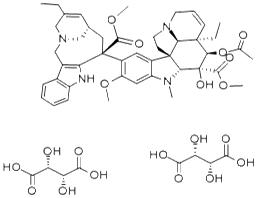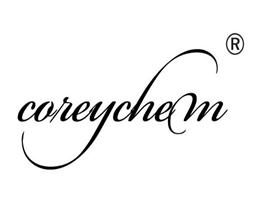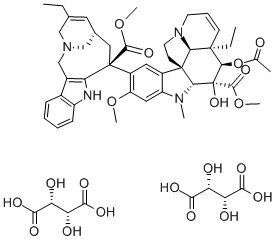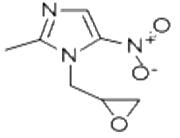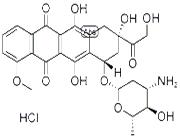| Overview |
Vinorelbine belongs to vinblastine derivatives, its action is similar to vincristine. It is first marketed in 1989 in France. The main role is to combine tubulin, consequently, it causes microtubule formation disorder during cells mitosis.
Vinorelbine belongs to cycle specific drugs, it is used clinically in the treatment of non-small cell lung cancer (NSCLC) and breast cancer, ovarian cancer, head and neck squamous cell carcinoma, leukemia. In addition,it also has a strong inhibitory effect on small cell lung cancer, colon cancer, brain tumors, malignant melanoma. |
| Pharmacological effects |
Vinorelbine tartrate is the tartrate form of vinorelbine ,it is a semi-synthetic vincristine compound, it belongs to M phase specific drugs, mechanism of action is similar to vincristine . Mainly it , by selectively blocking mitotic cell tubulin polymerization to form microtubule and inducing tubulin depolymerization , impedes spindle microtubules,and it makes cell division stop in the middle, and it has few effect on the synthetic tubulin in the shaft of nerve cells. Since NVB affinity for axonal microtubules is poor, only when there is a high concentration of it ,it has effect on axonal , so it has the lower neurotoxicity than other vincristine drugs,and it has a greater therapeutic index. Human pharmacokinetics of vinorelbine show that after intravenous administration there is a three-compartment model, the volume of distribution is large , PPB is up to 50% to 80%, plasma clearance rate is high, the terminal elimination phase T1/2 is 40 h, it has a rapid tissue distribution, concentration in tissues is significantly higher than vincristine (VCR), vindesine (VDS). Plasma clearance is 0.8 L/(kg • h),it is mainly through biliary secretion, and it is excreted with the feces, urine excretion accounts for 10% to 15%.It has a higher efficacy and less adverse reactions of the nervous system. |
| Clinical evaluation |
Numerous clinical studies have shown that vinorelbine is one of the most effective drugs for the treatment of non-small cell lung cancer and breast cancer, single agent response rate is 14% to 35% and 30% to 60% respectively. And DDP combination chemotherapy in NSCLC and with doxorubicin combination therapy of breast cancer, efficiency is up to 30% to 50% and 50% to 77%, respectively. It has a good effect on ovarian cancer, malignant lymphoma, head and neck cancer, esophageal cancer. |
| Adverse reactions |
- Vinorelbine hematologic toxicity is dose-limiting , mainly it is neutropenia, which mostly restore within 7d, it has a certain influence on red blood cells , thrombocytopenia and anemia incidence is less than 2%.
- Neurotoxicity mainly performs as tendon reflexes (about 25%), occasional paresthesia, few patients may have gastrointestinal autonomic nerve paralysis induced constipation (17%~41%), paralytic ileus is rare , 2% 6% of the patients suffer finger (toe) numb, but the incidence is much lower than the VCR and VDS.
- Incidence of gastrointestinal side effects is less than 10%. Occasionally, nausea, vomiting, dyspnea, and bronchospasm, often occur in a few minutes or several hours after treatment . Alopecia incidence is less than 10%.
- Vinorelbine drug extravasation into the surrounding tissue can cause burning, injection site phlebitis, local tissue necrosis, ulceration, cellulitis.
- Myelosuppression is dose-limiting toxicity. 3 to 5 days after the medication, transient myelosuppression can occur, usually it can recover within 10 days, attention should be paid to prevent infection. Neurotoxicity is visible.
|
| Chemical properties |
White or almost white powder or crystalline powder, odorless. |
| Application |
Antineoplastic agents |
| Chemical Properties |
Pale Yellow Powder |
| Uses |
An antineoplastic |
| Definition |
ChEBI: The L-(+)-tartrate salt of vinorelbine. |
| Biological Activity |
Selective mitotic microtubule antagonist that exhibits > 20 fold selectivity over axonal microtubules. Inhibits proliferation of multiple human tumor cell lines (IC 50 = 1.25 nM in HeLa cells) and blocks metaphase/anaphase transition by suppression of microtubule dynamics (IC 50 = 3.8 nM). Reduces spindle length by 29% and inhibits microtubule polymerization at micromolar concentrations. |

 China
China



